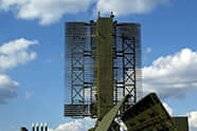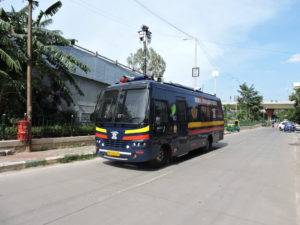Introduction
The first part of this article focused on the metrics that have a bearing on the decisions a user will need to make regarding the resolution of the surveillance camera and the type of lens to use, for a surveillance set-up. In Part II, we will discuss how to translate these metrics to camera resolution and lens specifications. In addition, we will briefly cover other camera-related factors that have an impact on surveillance planning.
Camera Resolution and Lens Characteristics
In order to arrive at a recommended camera resolution and lens specification, we will require information pertaining to Horizontal-Field-of-View (HFoV) and Vertical-Field-of-View (VFoV) for typical lens focal lengths.The following link has a lens chart that provides distance measures for lenses of various focal lengths: http://www.cctvcamerapros.com/Security-Camera-Lens-s/42.htm#lens-chart
Camera Resolution
(Source: http://www.theiatech.com/resolution.html)
The following formula allows a user to play with parameters such as pixels/foot-of-target, camera distance, sensor specifications, and focal length, to arrive at the best combination of camera resolution:
This formula calculates pixels/foot-of-target from the camera’s resolution and HFoV (which in turn is a function of lens focal length and camera distance). Let us take the example of the ~2 MP camera (1600 x 1200), with a 3.6mm lens:
The lens, at a distance of 25 feet, has an HFoV of 37.5 feet (as per the lens chart in the link above)
Using the formula, we can say that the 2 MP camera has an image resolution of approximately 46 pixels/foot (1600 / 37.5) at a distance of 25 feet (which is the camera distance at which a lens with a focal length of 3.6mm generates an HFoV of 37.5 feet)
If the user has a number in mind for pixels/foot-of-target, the camera resolution can be changed to arrive at the number. For example, if the required pixels/foot-of-target is around 100, at a camera distance of 25 feet with a 3.6mm lens, then the required horizontal resolution is 3750. That translates to something like a 11 MP surveillance camera (4008 * 2672).
Lens Characteristics
The second formula is useful in helping to reach a decision on the focal length that will be applicable for a particular surveillance setting:

(Source: http://www.theiatech.com/resolution.html)
This is a different variant of the earlier formula, and can be used to arrive at approximate values for the lens focal length required for a surveillance set-up, given camera distance, camera resolution, and pixels/foot-of-target. Let us take the example of the ~2 MP camera (1600 x 1200), with a 1/3” sensor:
- Assuming that the required pixels/foot-of-target is 50, and the surveillance camera is at a distance of 25 feet from the target
- The suggested focal length will be 3.75 mm (25 * 4.8 * 50 / 1600), where 4.8mm is the width of a 1/3” sensor.
If the user has a budget for the proposed surveillance set-up, or would like to try out simulations of different camera lens focal lengths in order to arrive at the best price/performance mix for a given surveillance area (width of coverage and depth); the above two formulae can be used along with the lens chart to decide on the optimal mix of number of cameras, of what resolution, and using what type of lens (fixed focal vs. vari-focal, and wide-angle vs. standard, rectilinear vs. fisheye, etc.).
Other Factors
There are a couple of other factors to consider when planning the surveillance of an area, and these are:
- The nature of the lighting at the area under surveillance
- Whether the surveillance set-up will be monitored in real-time.
Lighting
Information with regard to the nature of lighting at the area under surveillance will be useful in taking a decision on features such as low-lux lens support, IR light-source options, auto-iris versus fixed-iris lenses, and backlight compensation (BLC) support. A brief list of to-do’s in this regard are:
- The brightest and darkest lighting conditions (in lux) need to be determined, for each camera, for the area under surveillance. Based on these figures, a decision can be taken on whether it is better to pay extra and go in for a low-lux lens or whether the better option is to go in for an IR light-source. Typically, internal office spaces always have artificial lighting, so it may be more cost-effective going in for a low-lux lens on the camera than an additional light-source; whereas an internal retail outlet will have no lights on after working hours, making it more sensible to spend money on an additional light source rather than a low-lux lens
- Usually, the additional light-source is an IR light-source. The decision with respect to this feature, for a user, is whether to go in for an integrated (in the camera casing) IR light-source or an add-on IR light-source. This decision can be based on whether the need for the additional light-source is going to be permanent or transient, and whether the viewing distance is going to remain fixed or whether it is going to vary
- Auto-iris lenses are recommended for surveillance requirements where the source of light is going to be ambient lighting or where the area under surveillance is likely to have multiple levels of lighting. Fixed-iris lenses are ideal for artificial lighting situations, where there is a consistent level of lighting throughout the surveillance period
- Backlight Compensation (BLC) is an important feature when there are contrasting lighting conditions, in the area under surveillance, at the same time. For example, a surveillance camera positioned inside a retail outlet, but pointed at the entrance, is likely to have a mix of artificial lighting and bright sunlight whenever a customer enters the outlet. In such situations, to ensure usable surveillance footage, BLC is a must.
Real-time monitoring
It makes sense using PTZ cameras only if the area under surveillance is being monitored in real-time by trained surveillance personnel (either in-situ or remotely). In such cases, the careful use of optical zoom lenses can reduce the number of megapixel IP surveillance cameras required for the surveillance activity. On the other hand, in the absence of real-time monitoring, the use of PTZ cameras may be a waste of money. Currently, there exists fool-proof camera intelligence or video analytics that allows a camera to focus on events of interest, independent of human intervention, without leaving surveillance holes in the set-up.In case of a surveillance set-up where real-time monitoring is not available, there is a strong likelihood that digital zooming will be used for forensic requirements. In such cases, the digitally zoomed image will need to be at the minimum required resolution for the forensic activity at hand (recognizing a number plate or identifying an individual). This requirement may make it necessary to deploy higher resolution cameras for the surveillance activity than would otherwise be suggested, if real-time monitoring was available.
Conclusion
The difference between an effective video surveillance set-up and an ineffective video surveillance set-up is usually known too late – after a security incident has occurred. The additional queries covered in this article should allow the user to select the combination of cameras and lenses that deliver the best price/performance points.
The following utility (IP Video System Design Tool) assists a user to freeze on an ideal mix of camera and lens specifications for a given surveillance requirement: http://www.jvsg.com/.



